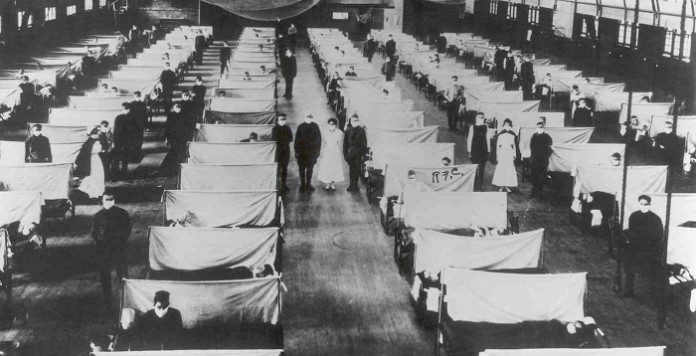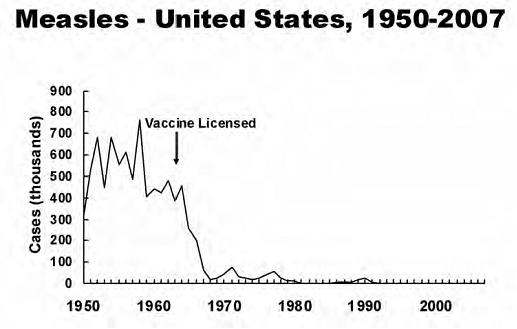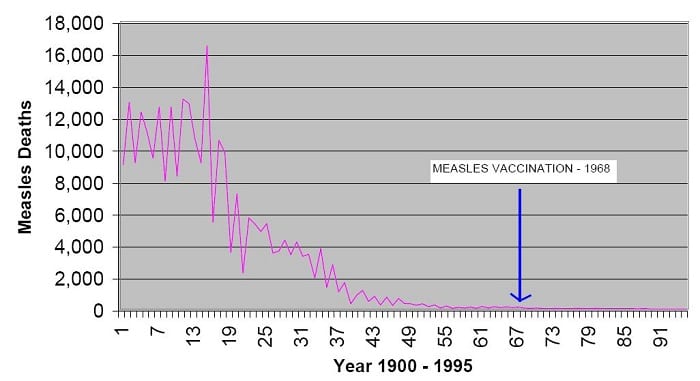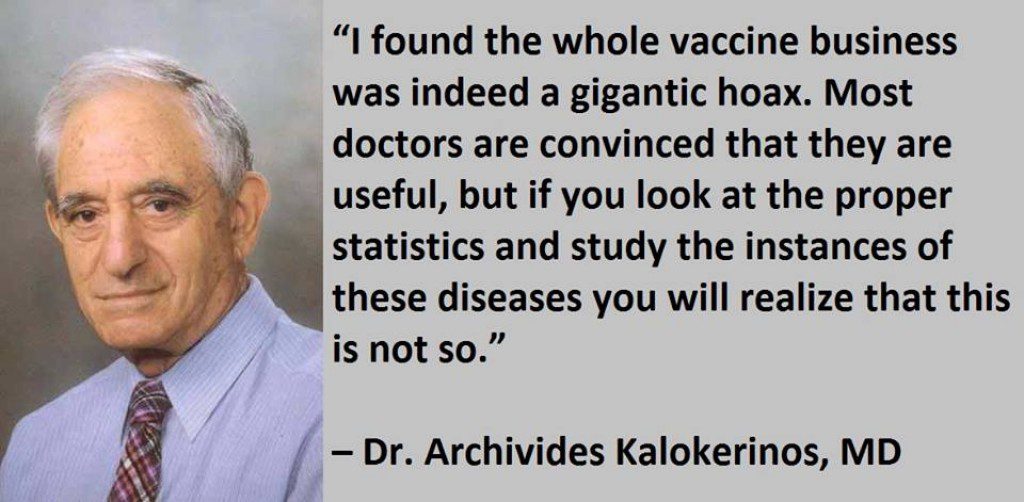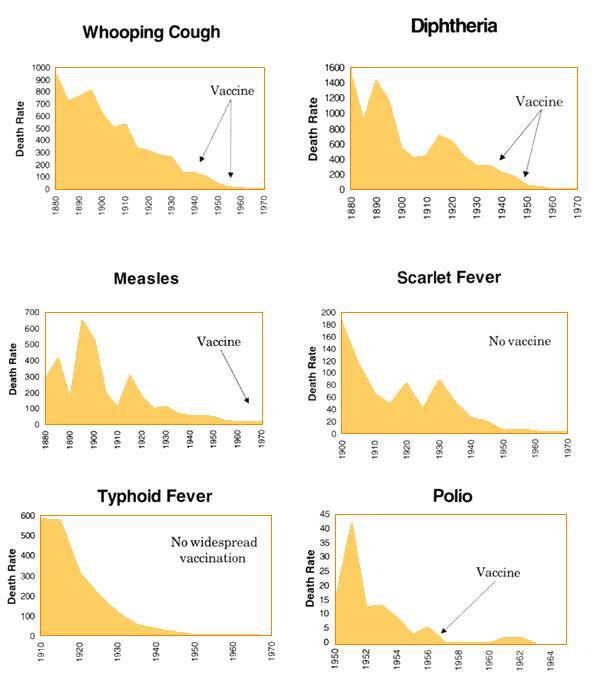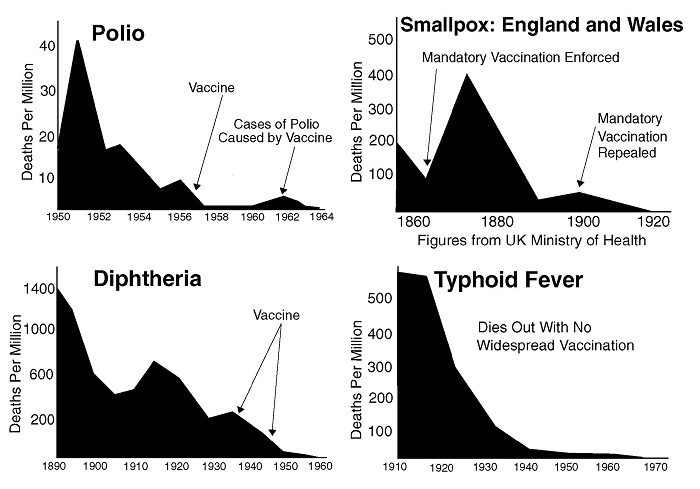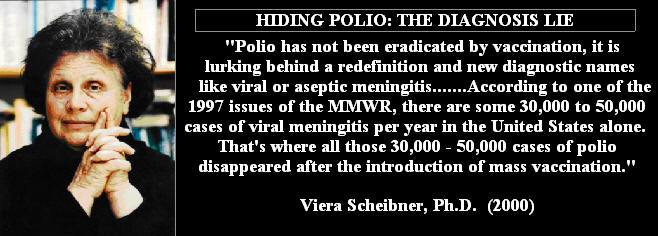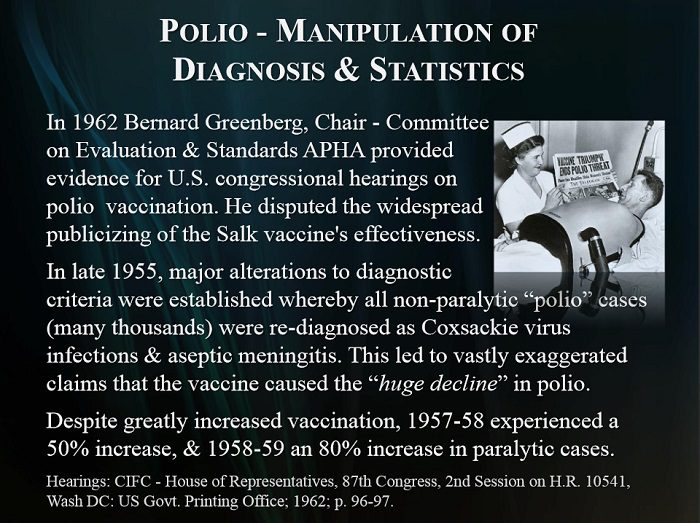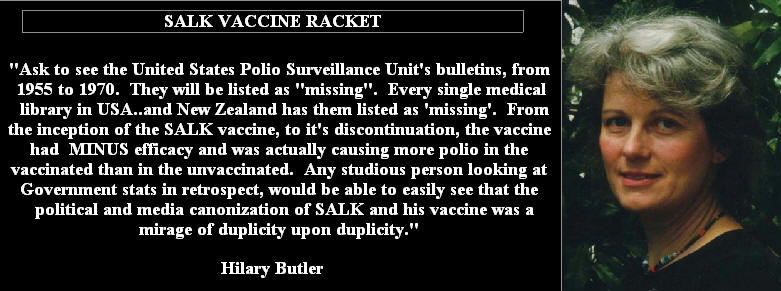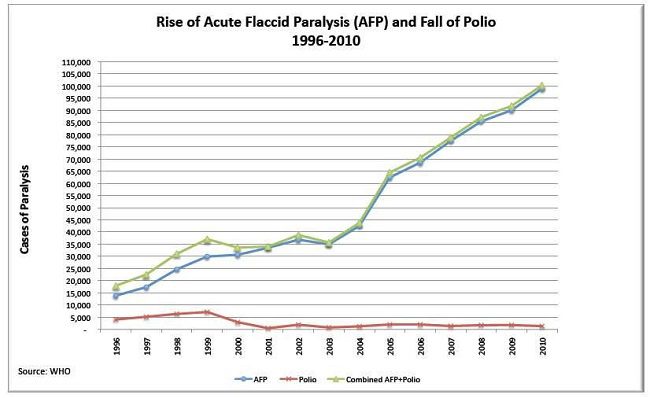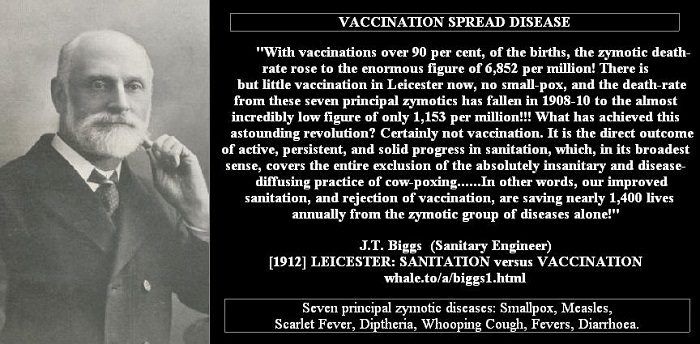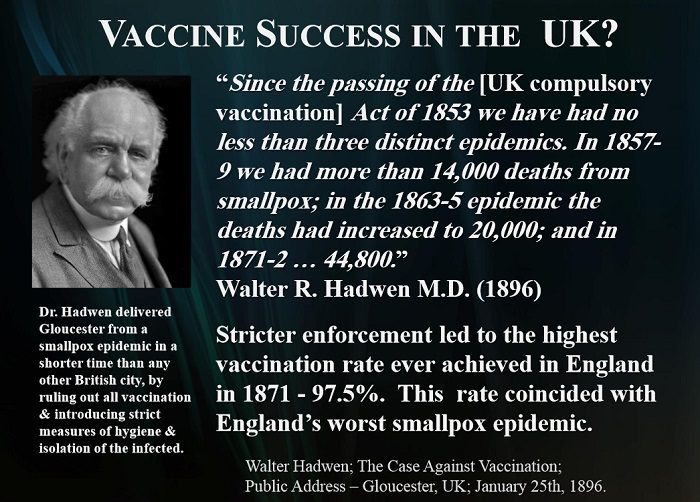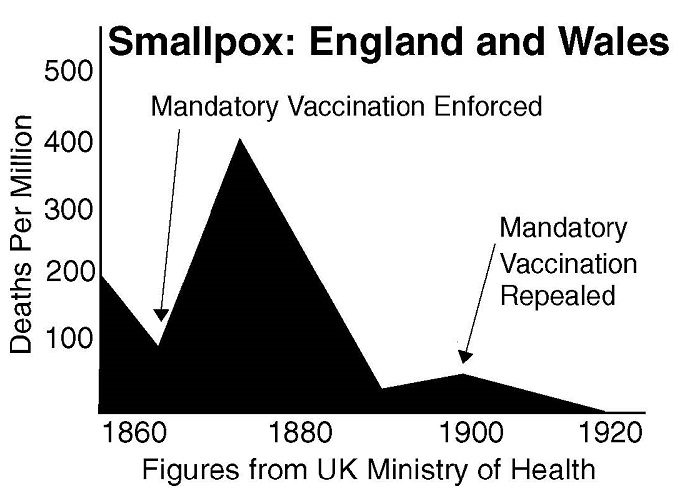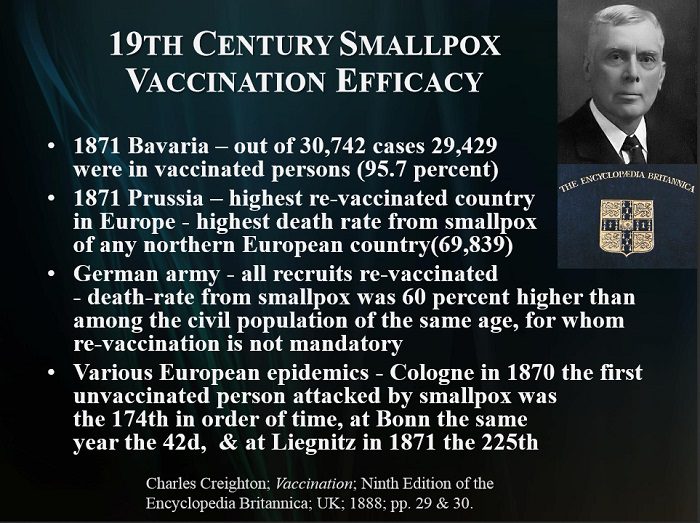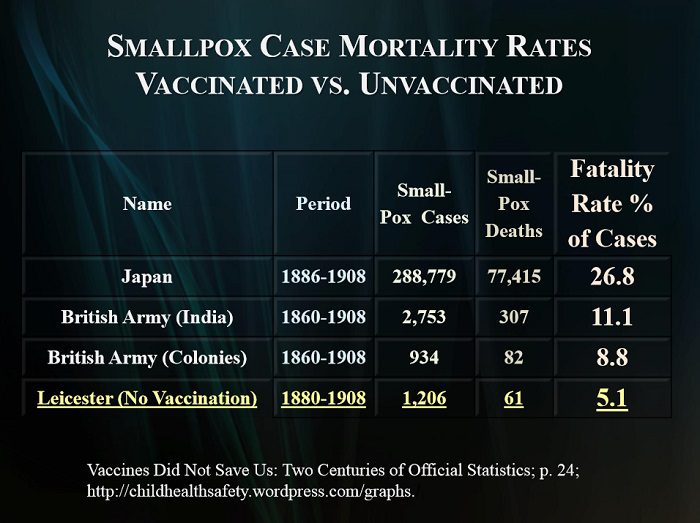A Comprehensive Review of Vaccines: Part 8 of 12
Vaccines and Infectious Diseases
If you ask most doctors about infectious diseases in the 20th century they will tell you that vaccines eradicated them, end of story! This is a particularly touchy subject within the vaccine debate and when we look at the facts supporting this theory, it is actually more akin to a religious belief than scientific fact. Our health officials continue to tell the same scripted story, but the whole body of evidence suggests otherwise. One of the ways this part of the debate has been stifled is that we are not even allowed to suggest that there may be other reasons diseases were eradicated, without being labeled a quack or kook. This is quite astonishing when you realize that the data for such an assertion is so weak and really tells a different story. In part 8 we will drill down deeper into all the information surrounding infectious diseases in the 20th century and find out what really eradicated them.
Historical Revisionism
We have been taught since grade school to believe that vaccines saved us from infectious diseases in the 20th century. Even though there have been scores of credible doctors with dissenting opinions about the role vaccines played in the eradication of diseases from their inception, right up to the present, those voices are ignored and we are taught a different version of history. The version of history that we are taught ignores empirical data and takes a more faith based approach involving agenda driven motives and dubious studies. Historical revisionism is not a new concept and scholars have been debating the interpretation of history since time immemorial. The difference we see in the vaccine industry is that there are powerful interests with a large stake in making sure the version of history that gets told is in line with their business model. As we mentioned many times in this series, vaccines are a business, and the vaccine market is significant, with enormous potential for growth.
An important part of the strategy is that the population truly believe that vaccines saved us from disease because that is the foundation for the whole theory of vaccines. This strategy has been very effective and our false belief that vaccines saved many of us from certain death is the reason most of us don’t question the science behind vaccines. It’s a powerful message and we hear it over and over again because they can’t take a chance on us forgetting. Here is just one example of how the case is carefully crafted to support the flawed theory, but there are many more like this article circulating around the web.
The website vaccines.gov is run by the National Vaccine Program Office, a division of US Department of Health and Human Services. Their list of identified responsibilities includes “necessity and effectiveness of vaccines”, with no reference to a responsibility for public health, by the way. The article is titled, “Vaccines are Effective” and it is a very brief treatment of the topic. Like the organization itself, the article approaches disease eradication by vaccine as a foregone conclusion. It attempts to breezily dismiss the substantial body of evidence that soundly refutes the claim that vaccines were responsible for eradicating diseases in the last century.
This article claims to put vaccines in perspective, but it actually presents limited data which narrows our perspective on the topic. Instead of using the historical mortality rate charts of infectious diseases, for example, they use an abbreviated version and address only measles cases. Here is the graph from the vaccines.gov site:
Notice how the chart only starts in 1950 and makes it appear as if the measles vaccine was responsible for the the eradication of measles. This hardly gives a proper historical perspective of the risk measles posed to the public in relation to vaccines. To consider only the number of diagnosed measles cases does not tell us much regarding the actual threat posed by the disease. Because we know that after 1950, the measles was a mild, short-lived virus in developed countries like the US, it is important to make a distinction between measles cases and measles mortality rates, which this article seems to purposely avoid.
To get a proper perspective on the real medical threat of measles we need to take a broader view using measles deaths, not cases. The graph above reflects measles deaths, beginning in 1838. It is a much more telling visual representation of the history of measles. As you can see, measles deaths were rare by the time the vaccines were introduced. This reveals that by the time the measles vaccine was introduced, the death rate had declined to fewer than 1 deaths per 100,000 measles cases, or less than 00.001%.
After 1950 Measles Were No Longer a Threat in the U.S.
The vaccine.gov article also states that the measles vaccine was licensed in 1962 and that’s when measles started to decline. What the article fails to mention is that the 1963 version of the measles vaccine was a failure which actually produced a deadlier form of the measles known as atypical measles. It wasn’t until 1968 that a second version of the vaccine was introduced, and by that time, measles mortality rates had dropped by 98%, making it a benign childhood disease. I’m not suggesting that measles is a pleasant sickness without discomfort, but in regard to public safety, measles was no longer a threat to our society after 1950, which is the start date on the misleading chart. So when we’re told that vaccines saved us, it’s just not true. We still have measles cases today, despite our aggressive vaccination program and very few people in the U.S. are dying or having serious complications as a result.
Measles is not the dangerous disease we are told and most of the complications we see in measles cases today are found in developing countries, not the U.S. Even The World Health Organization acknowledges that most measles complications happen outside of the U.S. The WHO also states that even in developing countries, only up to 10% of measles cases result in death. I certainly do not want to minimize any deaths, but statistically speaking, the measles is far less dangerous than we are led to believe. The Disneyland measles “outbreak” in 2015 that the media sensationalized was more of a vaccine marketing event than an infectious disease event. This was all over 150 cases of the measles in a country of over 300 million people.
Here is what the World Health Organization (WHO) states about measles deaths:
In populations with high levels of malnutrition and a lack of adequate health care, up to 10% of measles cases result in death. Women infected while pregnant are also at risk of severe complications and the pregnancy may end in miscarriage or preterm delivery. People who recover from measles are immune for the rest of their lives. Measles is still common in many developing countries – particularly in parts of Africa and Asia.
The overwhelming majority (more than 95%) of measles deaths occur in countries with low per capita incomes and weak health infrastructures.
– World Health Organization
A Historical Look at Infectious Diseases
In the video above, producer CGP Grey gives us some historical perspective on infectious diseases throughout the world. One of the main culprits for the prevalence of the plagues that were brought westward from Europe was horrendous sanitation practices. Notice how there is an emphasis on sanitation and that vaccines are not mentioned at all throughout the presentation.
Vaccinations or Modernity?
When we look at the whole body of information and published articles, it is difficult to make the case that vaccines were the reason infectious diseases were eradicated in the twentieth century. Instead, there is a much stronger case for improved sanitation practices and infrastructure, refrigeration, better nutrition, indoor plumbing and NATURAL herd immunity as the factors which resulted in plummeting disease rates.
Medical Intervention’s Contribution to Disease Eradication: 3.5%
When you review historical papers closer to the times of these deadly outbreaks you will find that medical intervention, including vaccines, had very little effect on mortality rates in the 20th century. John and Sonja McKinlay published an article in 1977, titled “The Questionable Contribution of Medical Measures to the Decline of Mortality in the United States in the Twentieth Century”, in which they carefully chronicle mortality rates in relation to medical intervention in the 20th century.
Here are some excerpts:
“…by the time laboratory medicine came effectively into the picture the job had been carried far toward completion by the humanitarians and social reformers of the nineteenth century… When the tide is receding from the beach it is easy to have the illusion that one can empty the ocean by removing water with a pail.”
“In general, medical measures (both chemotherapeutic and prophylactic) appear to have contributed little to the overall decline in mortality in the United States since about 1900-having in many instances been introduced several decades after a marked decline had already set in and having no detectable influence in most instances.”
“More specifically, with reference to those five conditions (influenza, pneumonia, diphtheria, whooping cough, and poliomyelitis) for which the decline in mortality appears substantial after the point of intervention-and on the unlikely assumption that all of this decline is attributable to the intervention-it is estimated that at most 3.5 percent of the total decline in mortality since 1900 could be ascribed to medical measures introduced for the diseases considered here.”
This landmark article concludes that vaccines and medicine, in general, had little to do with the decline in mortality from diseases for which most people still vaccinate.
Dr. Robert Mendelsohn
Dr. Robert Mendelsohn was one of the first medical doctors in North America to speak out about vaccine safety concerns:
“There is no convincing scientific evidence that mass inoculations can be credited with eliminating any childhood disease. While it is true that some once common childhood diseases have diminished or disappeared since inoculations were introduced, no one really knows why, although improved living conditions may be the reason.
“If immunizations were responsible for the diminishing or disappearance of these diseases in the United States, one must ask why they disappeared simultaneously in Europe, where mass immunizations did not take place.”
Disease Rates in Relation To Vaccines
We are told that sanitation had no role in the eradication of infectious diseases from articles like the one we mentioned earlier from the vaccines.gov site. The article makes a fairly simple argument using polio, HIB and pneumococcal meningitis. We will address polio later in this part. The main point the article makes is as follows:
“If the drop in disease were due to hygiene and sanitation, you would expect all diseases to start going away at about the same time.”
When we look at the data, that is exactly what we see. Most of these diseases diminished around the same time, right after 1950. Here are several charts from the U.S. and other countries illustrating the risks of infectious diseases in the 20th century and their relation to vaccines. In addition to the fact that infectious disease mortality rates dropped by over 90% before the vaccines were ever introduced, Scarlet Fever and Typhoid Fever had no widespread vaccination campaign and yet they diminished at the same rate (or better) than the diseases that did have vaccines. How do we know that all of the infectious diseases would not do the same without the presence of vaccines? As you can see in some of the charts, vaccines sometimes actually made things worse.
The above graph reflects data from Australian public health records.
Vaccines Are Not What Eradicated Disease
The data in these charts clearly show us that vaccines are not the reason these diseases subsided. If anything, the data coincide with better living conditions, sanitation awareness, refrigeration, nutrition and the implementation of indoor plumbing in the early to mid 1900’s. Vaccines were introduced long after the downward trends of diseases were firmly established. This should be no surprise to us because we see this same trend in developing countries. They are simply going through what we went through 50 or 100 years ago. Most of the deadly cases of infectious disease are in countries which lack the modern living standards attained in the US over the past 100 years. Unfortunately, rather than helping underdeveloped countries to build better infrastructures, with improved nutrition and clean water, the world’s health agencies are shipping vaccines to them. In some cases, vaccines used overseas are reported to have caused great damage.
A Closer Look at the History Behind Polio
The video above was posted in 2013 and is a presentation by Dr. Suzanne Humphries on the eradication of polio and the role of the polio vaccine. Dr. Humphries explains how several specific factors are actually responsible for the decline of polio. Dr. Humphries has co-written a book on this topic, Dissolving Illusions: Disease, Vaccines, and The Forgotten History, in which she comprehensively explores these factors in great detail.
Dr. Humphries, among others, describes the history of polio as a drastically different story than what we’ve commonly understood. Far from the perception of polio as a dangerous, virulent and deadly disease, the reality is that polio is an enterovirus, which means that it lives in the human gut. CDC estimates that 95% of those who become infected with polio experience no symptoms at all. About 4-8% have minor, flu-like symptoms. Less than 1% of polio cases result in permanent paralysis of the limbs, usually the legs. Only 5-10% of this less than 1% die when polio paralyzes the respiratory muscles. Dr. Humphries asks: “What other vaccine-targeted illness do you know of that is asymptomatic in 95% of people infected?”
It turns out that spikes on historical polio graphs actually reflect some other things that were going on at those times which resulted in the epidemic diagnoses (sometimes incorrectly) of polio.
The 1916 Spike
Dr. Humphries makes a case for the following as factors influencing the epidemic-level upticks we see in polio throughout recent US history.
1916 was the year of the largest and most devastating polio epidemic in US history. There were 23,000 cases and 5,000 deaths. Deaths should be 5-10% of 1% of those infected, but it was almost 25% with this epidemic. Dr. H.V. Wyatt published about this phenomenon in 2011. In 1916, there was a unique polio virus being refined just three miles from the epicenter of the epidemic in New York City. It was called the MV strain and scientists were trying to produce the most virulent strain of polio possible. Polio epidemics occur from late summer to early fall. This spike was unusual because it occurred in the spring. Wyatt makes a compelling argument that this epidemic started from exposure to this MV strain polio.
The 1950’s Spike
The next spike in polio occurred in the 1950’s and Dr. Humphries discusses changes in the causes, treatment and susceptibility factors as well as the definition of polio.
Breast feeding: The 1930s and ’40s saw a steep rise in formula feeding. Babies who were breastfed, and who received no other form of nourishment, did not get polio. When you added fruit or cow’s milk to the diet, the benefits vanished and these children were susceptible to polio. Dr. Humphries thinks there are 4 reasons for this: 1. Lack of maternal disease protection babies get from breast milk, 2. Toxicity and inferiority of formula, which can never be a good substitute for breast milk, 3. DDT used in cows was present in milk and 4. Formula is an immuno-suppressant. Breast milk is a living organism that contains stem cells and probiotics and it inactivates pathogens and protects babies.
Dr Humphries suggests that what took polio from being a relatively harmless inhabitant of the normal gut, to a terrifying disease for some, can be described by the idea of synergy. Synergy refers to added circumstances that, alone or in combination, interact with a virus to make it more virulent. Here are some of the synergistic factors that have been clearly linked to the diagnosis of polio, particularly during the US epidemics of the 1950’s:
- Intramuscular injections can cause provocation polio. Breakage of tissue and blood vessels allows access of the virus, when it is already in the bloodstream, to access the peripheral nerves and get into the central nervous system, causing paralysis.
- Tonsillectomies can also cause a type of provocation polio. Tonsillectomies became very popular during the 1950’s. Tonsils serve as gate keepers of lung and intestinal immunity, protecting us from things we breathe or swallow. Removing tonsils gives toxins direct access to the brain stem and rest of the body, instead of being trapped in the throat and intestinal lymphatic zones. Historically, polio was much more prevalent in those who had their tonsils removed.
- White sugar is another factor that was available in abundance during the polio epidemics of the 1950’s. White sugar was processed with bleach, chemicals, disinfectants and quick lime. In 1948, there was an outbreak of polio in North Carolina. Dr. Benjamin Sandler did an experiment in sugar consumption. He widely broadcast his theory that reducing sugar consumption would reduce the chance that polio would result in paralysis. People listened and, in 1949, the state saw a 90% decrease in poliomyelitis.
- DDT: Humphries shares a slide that graphs polio incidence and pesticide production in the US between 1940 and 1970. The line graphing polio incidence follows exactly the same trajectory as the production of pesticides. DDT was marketed as being safe and effective, even for use around babies. There is footage from the 1950’s that documents, in horrifying detail, the common practice of dousing children with DDT. Eventually, it was discovered that DDT induces symptoms that are indistinguishable from poliomyelitis. DDT enhances the release and multiplication of the polio virus. Other pesticides in wide use were also shown to increase the multiplication rate of the polio virus.
- Arsenic was also considered safe and especially good for children and was widely used at the height of the 1950’s polio epidemics. It was used in common household items as well as medications, such as ‘Tryparsamide’, manufactured by Merck in the 1930’s. It was used to treat syphilis, often in a series of 100 injections. Arsenic poisoning has been shown to cause symptoms in cows which look just like polio. Cows don’t get polio.
- Polio was redefined when the Salk vaccine was marketed and began being sold. Before 1954, two doctor exams, 48 hours apart, were required to diagnose paralytic polio. That means that a person could have had paralysis for 24 hours and even if that person made a full recovery (as would almost always be the case), that person would have been counted among those diagnosed with paralytic polio. After the Salk vaccine was introduced, the requirement for diagnosis was changed to two doctor exams, 60 days apart. Obviously, this made it appear that there was a decline in polio that coincided with the introduction of the polio vaccine. It’s no wonder everyone thought the vaccine was responsible. Another definition happened to occur as the Salk vaccine was rolled out. This time it was the definition of an epidemic. Before 1954, a polio epidemic was defined as 20 diagnosed cases out of 100,000 people, but the definition was almost doubled, requiring 35 diagnosed cases out of 100,000 people before it could be called an epidemic. Of course, again, you can see why it looked like the Salk vaccine saved us all from polio.
The Salk Vaccine
Dr. Humphries describes a fatal flaw in Salk’s polio vaccine: the formaldehyde was not sufficient to kill the polio virus. A Swedish virology expert warned the powers that be that this was the case but he was ignored, as are skeptics today. Salk’s vaccine virus was actually impossible to sufficiently inactivate with formaldehyde. Some bottles of the vaccine passed all safety tests but when sampled from the bottles 3 months later, they were full of live virus.
The Cutter Incident occurred in 1955. It refers to an incident whereby at least 220,000 people were infected with polio after receiving a vaccine with live virus of a virulent strain of polio. Ten were killed, 164 were severely paralyzed, 70,000 experienced muscle weakness and millions were likely exposed to polio as a result. An estimated 40,000 cases of abortive polio (milder version) resulted from the mistake. The reason this happened was because of the fatal flaw mentioned above. In order to reduce the amount of live virus, the vaccine virus had to be watered down drastically.
The Salk polio vaccine that was celebrated as ending polio was actually an ineffective vaccine. It was either a live virus that infected people with polio or it was so watered down, that it didn’t stimulate the immune system to provide protection from polio. When the Salk vaccine was replaced after a few years with the Sabin oral polio vaccine, protocol dictated that children who had received the Salk vaccine get 3 doses of the new one. This fact shows that the pharmaceutical company, those in charge of public health and the medical community knew about the fatal flaw with the Salk vaccine. Instead of admitting the mistake, they covered it up and silenced those who spoke out about it, according to Humphries.
Polio Re-defined
This set the stage for where we find ourselves today. We’re accustomed to constantly changing vaccine protocols. We don’t ask why or what changed. Parents are conditioned not to question vaccines. Humphries calls this ‘officially sanctioned history’.
What used to be diagnosed as polio is now called ‘transverse myelitis’ and those who used to be in an iron lung are now on respirators. There are 30,000 cases of this every year.
“Acute Flaccid Paralysis (AFP) is just another name for what would have been called polio in 1955, and the term is used to describe a sudden onset of paralysis. It is the most common sign of acute polio, and used for surveillance during polio outbreaks. AFP is also associated with a number of other pathogenic agents including enteroviruses, echoviruses, and adenoviruses, among others. But in 1955, there was no attempt to detect anything other than polio in cases of AFP. Once the vaccine was mass marketed, the game changed, according to Dr. Humphries. Polio didn’t disappear, they just call it AFP or one of many other names: Transverse Myelitis, Guillain-Barré syndrome, enteroviral encephalopathy, traumatic neuritis, Reye’s syndrome and aseptic meningitis, to name a few.
AFP (acute flaccid paralysis) appears to have developed from a vaccine polio virus. In developing countries like India, data show that the wild virus is declining while vaccine strains of polio have recombined and strengthened. The epidemics experienced in some countries currently are in direct correlation to those children vaccinated for polio. Children in India have been shown to be more than twice as likely to die from the virus version of polio as from the wild version.
Here are some excerpts from the article by Dr. Suzanne Humphries, Smoke, Mirrors and the “Disappearance” of Polio:
Unbeknownst to most doctors, the polio-vaccine history involves a massive public health service makeover during an era when a live, deadly strain of poliovirus infected the Salk polio vaccines, and paralyzed hundreds of children and their contacts. These were the vaccines that were supposedly responsible for the decline in polio from 1955 to 1961! But there is a more sinister reason for the “decline” in polio during those years; in 1955, a very creative re-definition of poliovirus infections was invented, to “cover” the fact that many cases of ”polio” paralysis had no poliovirus in their systems at all. While this protected the reputation of the Salk vaccine, it muddied the waters of history in a big way.
Even during the peak epidemics, unifactorial poliovirus infection, resulting in long-term paralysis, was a low-incidence disease that was falsely represented as a rampant and violent crippler by Basil O’Connor’s “March Of Dimes” advertising campaigns. At the same time as Basil O’Connor was pulling in 45 million dollars a year to fund the Salk vaccine development, scientists started to realize that other viruses like Coxsackie, echo and enteroviruses, could also cause polio. They also discussed the fact that lead, arsenic, DDT, and other commonly-used neurotoxins, could identically mimic the lesions of polio. During the great epidemics in the United States, the pathology called polio was reversed by alternative medical doctors who attested to great success, using detoxification procedures available at the time – yet they were categorically ignored.
Now it is admitted in the medical literature that other viruses can cause polio, yet few people on the street have any idea.
Prior to 1954, the following undoubtedly hid behind the name “poliomyelitis”: Transverse Myelitis, viral or “aseptic” meningitis, Guillain-Barre Syndrome (GBS)- (what Franklin Delano Roosevelt had), Chinese Paralytic syndrome, Chronic Fatigue Syndrome, epidemic cholera, cholera morbus, spinal meningitis, spinal apoplexy, inhibitory palsy, intermittent fever, famine fever, worm fever, bilious remittent fever, ergotism, post-polio syndrome, acute flaccid paralysis(AFP).
Before you believe that polio has been eradicated, have a look at this graph of AFP and Polio. If you are wondering why there is no data prior to 1996, go to the WHO website for AFP and you will see that there is no data prior to 1996, and note that AFP conitnues to rise in 2011.
When people ask me where all the children on iron lungs are, I would answer that they should ask Dr. Douglas Kerr from Johns Hopkins, who stated on pg. xv in the Forward to Donna Jackson Nakazawa’s book “The Autoimmune Epidemic”…
“Infants as young as five months old can get Transverse Myelitis, and some are left permanently paralyzed and dependent upon a ventilator to breathe… my colleagues at the Johns Hopkins Hospital and I hear about or treat hundreds of new cases every year.”
Does the public have any idea that there are hundreds of cases of something that would once have been called polio, and some of those children will be dependent on a modern version of the iron lung? No. Parents today think that the Salk vaccine eliminated any need for ventilators, because the pictures of all these children on iron lungs are no longer paraded in front of people in order to create fear. Besides which, today’s “iron lungs” don’t look like a prototype submarine. They are barely recognizable as today’s “ventilators.”
The polio vaccine had the fastest licensing in FDA history. It was approved for commercial production after only a two-hour deliberation amongst the Licensing Committee, in a pressured environment. These scientists witnessed a vaccine that was escorted to market, before academic and community doctors had a chance to read any published reports on the safety studies, and before the results of the big polio vaccine trial made it into any medical journal. If these scientists had had more say, it is likely that the “Cutter” disaster and the “Wyeth problem,” both events that led to crippling or death of vaccine recipients just weeks following the hurried vaccine licensing – could have been averted.
Dr. Humphries quotes the following testimony that was part of the opening brief of a lawsuit involving Cutter labs and it references how the vaccine was actually brought to market.
“Previously it [the vaccine] had been distributed as an experimental product, not a licensed product…the committee was asked to come to a decision very quickly…there was discussion of the report that Dr Francis had given, but we were not in a position to discuss it very intensively because we had not seen the report prior to this morning and the report was distributed to us after the presentation…we were pressured in the sense that we were told that speed was essential, and when we came up toward the 5:00 time, some of us felt we would like to discuss this matter more. We were told that to discuss the matter further it would have to go into the following week, and we would have to go to Washington or Bethesda and most of the members were unwilling to do so. We were in effect pressured into an earlier decision than we ordinarily would have made. …It was part of the pressure of events, put it that way.”
And that is only the beginning of the polio story, the likes of which currently serve as the foundation of modern belief in vaccination, even by those who may have doubts regarding current vaccine policy.
What About Smallpox?
Smallpox is another disease that has been historically misrepresented and a lot of the facts have been conveniently forgotten. Here is an excerpt from a November, 2005 article by Lynn Borne from the Weston Price Organization, addressing the role of vaccines in eradicating disease:
While we have all been taught that vaccination ended the world’s many deadly epidemics, an honest and careful review of original historical medical sources, publications and statistics from the past two hundred years reveals that infectious diseases declined 90 percent before mass vaccination was ever introduced.
Experts attribute the cessation of epidemic diseases not to mass vaccination, but to a major sanitation reform movement that swept Europe during the 1800s. These reforms included moving human waste out of streets via plumbing systems; regularly cleaning streets and stables of horse manure and human waste; improving roads so that meats, vegetables and raw milk could be distributed in cities while still fresh; and upgrading water distribution systems to prevent bacterial contamination.
All the old terror diseases of plague, black death and cholera responded to these reforms, and epidemics declined throughout the 1800s, long before the advent of vaccination. Even the CDC reported in 1999 that infectious diseases declined in the past century due to improvements in sanitation, water and hygiene. Vaccination against whooping cough, diphtheria, measles and polio all occurred only at the very end of the life cycle of each epidemic, exposing the fallacy of the claim that vaccination ended epidemics.
The only exception to this decline in epidemic disease is smallpox, which, contrary to all we have been taught, actually increased with the advent of mandatory vaccination and decreased only after an organized uprising by parents and doctors forced European governments to end their mandatory vaccination programs. Even though the World Health Organization claims credit for the eradication of smallpox worldwide through vaccination, the fact is that smallpox declined in countries around the world whether the population had been vaccinated or not.
As Dr. Glen Dittman said in 1986:
“It is pathetic and ludicrous to say we vanquished smallpox with vaccines, when only 10 percent of the population were ever vaccinated.”
Leicester
Towards the end of the 19th century, the town of Leicester had one of the highest small pox vaccination rates in England. Despite this, Leicester became the site of a hideous small pox epidemic in 1871. The death rate skyrocketed, far beyond what was experienced in London, where vaccination rates were much lower and sanitation conditions much worse. The public started catching on to a connection between the vaccinations and the epidemic and began refusing vaccinations in droves. By 1890 vaccination rates in Leicester were down from 95% to 5%. Once they made a decision to stop vaccinations, they saw a direct improvement in their small pox numbers. Eventually they were able to bring the disease under control without using vaccines. Dr. Humphries goes into detail about this in her book, Dissolving Illusions: Disease, Vaccines and the Forgotten History.
Source: Vaccine Choice Canada – Raymond Obomsawin
Yale Professor Talks About Sanitary Movement
This Yale History lecture offers a thorough discussion on the topic of sanitation and its historical role in eradicating disease.
Let’s ask some simple questions. What hard proof do we have that vaccines are effective? Knowing what we now know about vaccine efficacy, how can we be sure that vaccines offer protection from disease? We have countless examples telling us they do not. What credible clinical data do we have that vaccines even work at all? The science behind vaccine efficacy is far from conclusive and is extremely dependent on interpretation. What if all these vaccinated people were never at particular risk of catching the disease in the first place?
Maybe it’s not safe to assume that a decrease in epidemics equals vaccine success. We now know that those who are vaccinated will shed the disease. What role does shedding play in some of the outbreaks we are hearing about lately? When it comes to irrefutable proof, vaccine science is actually more like a religion, requiring us to place our blind faith in pharmaceutical companies and the medical establishment to have our best interests at heart.
Wealth Equals Health
More Wealth Equals Better Health
In the video above, Hans Rosling takes a unique historical perspective which shows the direct correlation between the wealth of a country and improved overall health. With wealth comes a better standard of living through things like electricity, refrigeration, better nutrition, better sanitation, food distribution, etc. Most people cannot relate to the poverty and poor conditions that were prevalent 100 years ago but such conditions were a significant factor in these infectious disease epidemics.
Summary
It’s difficult for most people to believe that vaccines did not play a major role in the eradication of infectious diseases in the 20th century but the data simply does not support that theory. We are led to believe that it is an open and shut case, but it clearly is not. As we can see from taking a look at the whole body of information available, it seems clear that the opposite is true. In fact, it is a real stretch that people make the argument, in light of the data. It seems the further removed we are from historical events, the easier it is for history to be revised in favor of the powerful interests that stand to benefit from the revisions.
This is Part 8 in the 12 part series: A Comprehensive Review of Vaccines
Part 1: Why Are So many People Choosing Not To Vaccinate?
Part 2: A Closer Look at Pharmaceutical Companies
Part 3: Vaccine Policymakers and Conflicts of Interest
Part 4: How The CDC, FDA and WHO Lost the Trust of Vaccine Skeptics
Part 5: Are Vaccines Safe & Effective?
Part 6: What Are The Real Risks of Not Vaccinating in the U.S.?
Part 7: Herd Immunity, Shedding and the Questionable Science Behind Vaccines
Part 8: Did Vaccines Really Eradicate Infectious Diseases in the 20th Century?
Part 9: The Conclusive Evidence Linking Vaccines and Autism
Part 10: Why Don’t We Hear The Whole Story About Vaccines?
Part 11: What Are Independent Experts Telling Us About Vaccines?
Part 12: Vaccines: The Greater Good or Greater Greed? – Conclusion
Speed the Shift is an independent group of researchers on a mission to find the truth about controversial topics. We utilize alternative information sources that are often ignored or outright censored by the corporate media in an effort to gain a broader awareness of relevant issues.







